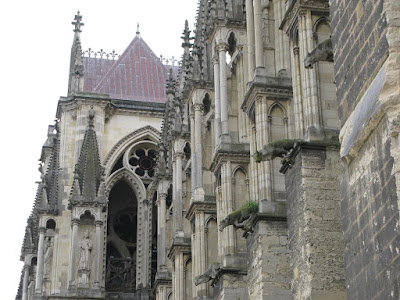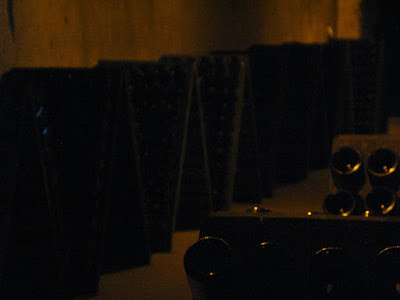Hello, everybody, Bonjour a tous! Welcome back to Cépage et
Cuisine, Mary’s and Brian’s blog about wine, food, and
culture. May 29 was a Sunday, a day when
small producers are closed. We spent it
in Reims, visiting historical cultural sites, and touring the caves of
Champagne Taittinger, a large producer that is headquartered there.
Reims (pronounced Rauntz
with a gargled French R sound; don't ask) is steeped in ancient and modern history. Our first destination was the Cathedral
Notre-Dame de Reims, perhaps one of the most famous sites in France. First, the Cathedral is the church in which
coronation and blessing of French royalty occurred, literally the church of
kings.
Second, it has a
longevity that is all the more remarkable, considering what it has
endured. It was built in the 13th
century, making it almost 700 years old, and replaced an even older church on
the same site that was destroyed by fire.
That means that, in addition to the wars of the 20th century,
it has seen numerous earlier conflicts.
It is a magnificent
structure, inside and out. This short
video was made as we approached at 11:00 on a Sunday morning. Sorry about the shaky image, but I recorded
as we walked and it was raining.
This second video (below) and the photo that follows were recorded before I realized photography is not
allowed during mass.
Here are some exterior
photos of the exquisite statuary and sculpture.
The cathedral was
terribly damaged during World War I.
Here you can see the scars of shell fire on this wall.
Some of the sculpture was
damaged although I imagine that time and the exposure to the elements also
contributed. Restoration is an ongoing
process 100 years later.
After a quick lunch we
went to Taittinger but had to wait an hour for an English language tour.
The guide suggested we walk down the street
about three blocks to visit the Basilica Saint Remi. I’m so glad we did.
This church is almost as
old and majestic as the cathedral. It
doesn’t have the history of coronations, but it was designated as a basilica by
the pope, indicating special significance in the Catholic faith. Mary and I aren’t exactly sure about the
difference between a cathedral and a basilica.
Mary thinks it might be that one is the home church of the
archbishop. Perhaps one of you alert
readers can shed some light on the question.
For part of our visit, we
had the entire basilica to ourselves. Here’s a view from the
rear.
And Mary in a moment of
quiet reflection
Like the church in
Chouarce, there are many precious sculptures that are centuries old.
Like the Cathedral
Notre-Dame de Reims, the Basilica Saint Remi was heavily damaged in the 1914
assault on the city. This photo on
display gives an indication.
This sign tells a little
of the story and as best I could translate it online, I think it says: “During the war of 1914 Saint Remi received many
shells. The vaults of the axial chapel were
slaughtered. The 9 high windows in the
center of the apse disappeared. On August
1, 1918, during a terrible bombardment, the nave, covered with a vault of wood
and plaster, was set fully ablaze. There
is nothing left of the roof and the nave remains an open pit.”
Then we walked back to Champagne Taittinger for
our tour. It was a large group, perhaps 30,
all English speaking. We descended by a spiral
staircase into the caves and cellars 18 meters below the surface. Taittinger is on the site of a former abbey,
the ruins and reminders of which are easily seen during the tour.
The caves are an interesting
story in themselves. There are 17
kilometers of them under the city, 10.5 miles!
The tunnels allowed the monks to move around from church to church. During the fighting in 1914 and much of the
occupation, thousands of civilians took shelter in the chalk tunnels, living
there for months or even years. It was like a city beneath a city, including
merchants, butchers, and bakers. During the second world war, the caves were
used to hide the most precious wines.
Here you see some wall
graffiti from that terrible time. Guerre is translated to war.
These galleries are
throughout the tunnels and hold precisely 99,950 bottles of Champagne and take
two men two weeks to fill by hand.
These bottles are in
racks for a process called riddling. Riddling allows sediment in the bottle to
gradually move to the neck of the bottle for disgorgement.
Here’s a quick video below from YouTube that
demonstrates how riddling is done. Each
bottle is turned one-eighth at a time about two or three times per week.
This is a stairway tunnel,
several hundred years old, used by the monks to come from the surface and
retrieve bottles of wine.
This is a chalk pit that
shows how the Romans mined chalk from the earth to use to build the cathedrals
and other buildings in France. It is
hard to convey the massive dimensions of the space but they were quite expert
engineers. The space is narrow at the
top and enormous at the bottom in a pyramid design in order to keep it stable
and prevent cave ins.
After the tour, we climbed
back upstairs and had a nice tasting of four wines, although a little crowded for my preference.
We began with their basic Brut and finished
with their premium wine, called Comtes de Champagne, all beautiful.
Back at the gite, we cooked in for dinner. It was just a simple dinner but we paired it
with this bottle from our host, Mathilde Weber, who gifted it to us upon our arrival.
They produce Champagne Alfred Tritant, which I’ll describe in more
detail in a couple of days. The gite is a converted attic space in their
house. The wine was delicious and
refreshing with great acidity, lemon citrus, and fine effervescence. It was a nice end to a fascinating day,
despite all the rain.
That’s our post for
today. We hope you found it
interesting. Every time we visit these
ancient and precious sites, we come away humbled and amazed. The Cathedral Notre-Dame de Reims, the
Basilica Saint Remi, and the chalk tunnels under the city are all UNESCO World
Heritage sites.
Thanks for reading us at Cépage et Cuisine. Please comment and let us know what you
think. We have one more day in Champagne
before we transition to our next stop in Germany. In the meantime,
Cheers,
Mary♥Brian






























No comments:
Post a Comment